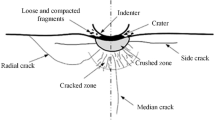Abstract
This paper presents the results of simple and double indentation tests conducted on three hard rocks: granite, limestone and sandstone. The main objective is to analyze the rock behavior under indentation test in relation with the physical and microstructural properties. First, the experimental set-up used during the tests is described as well as the sample preparation. Then, an image analysis based technique is applied on thick sections made from the tested samples in order to evaluate the size of indentation-induced cracked zone and to assess the crack types (vertical or sub-horizontal) below the indenter. The interpretation of the results was made on two levels. First, several physical parameters (energies and displacements) have been derived from the so obtained experimental indentation curves. Very high correlations were found between the loading, indentation and specific energies versus the plastic displacement. Second, cracked zone radius was estimated showing a very high correlation to the specific energy and governed by the physical and mineralogical properties of the tested rocks. Finally, the analysis of double indentation tests proved that changing the distance between two adjacent inserts allows the determination of the optimal spacing producing overlay of cracked zones and causing rock damage and large chip departure.











Similar content being viewed by others
References
Alehossein H, Hood M (1996) State of the art review of rock models for disc roller cutters. In: Aubertin M, Hassani F, Mitri H (eds) Rock mechanics, Rotterdam, Balkema, pp 693–700
Aubertin M, Hassani F, Mitri H (eds) (1996) Second NARMS, rock mechanics tools and techniques. Balkema, Montreal, pp 693–700
Aziz N, Guo H (1992) Sub-surface cracks due to disc cutter spacing for improved rock breakage and ground control. In: 11th international conference of ground control in mining, The University of Wollongong, NSW, Australia, July 1992, pp 667–675
Banks S (2013) Minimising the mechanical specific energy while drilling using extremum seeking control. In: Dimitrovova et al (eds) 11th international conference on vibration problems z. Lisbon, Portugal, 9–12 September 2013
Bao RH, Zhang LC, Yao QY, Lunn J (2011) Estimating the peak indentation force of the edge chipping of rocks using single point-attack pick. Rock Mech Rock Eng 44(3):339–347
Chen LH, Labuz JF (2006) Indentation of rock by wedge-shaped tools. Int J Rock Mech Min Sci 43:1023–1033
Copur H, Bilgin N, Tuncdemir H Tuncdemir, Balci C (2003) A set of indices based on indentation tests for assessment of rock cutting performance and rock properties. J South Afr Ins Min Metall 103:589–600
Haftani M, Bohloli B, Nouri A, Javan MR, Moosavi M, Moradi M (2015) Influence of penetration rate and indentation diameter in strength measurement by indentation testing on small rock specimens. Rock Mech Rock Eng 48:527–534. doi:10.1007/s00603-014-0563-3
Hamdi E, Audiguier M, du Mouza J, Fjäder K (2003) Blast induced micro cracks assessment in muckpileblocks: P-wave velocity and porosity measurements. European Federation of Explosive Engineers. In: Proceedings of the 2nd world conference on explosives and blasting technique, 10–12 September 2003, Prague, Czech Republic, pp 389–399
Hamdi E, Bouden Romdhane N, du Mouza J, Le Cléac’h JM (2008) Fragmentation energy in rock blasting. Geotechn Geol Eng 26:133–146
Hamdi E, Bouden Romdhane N, LeCléac’h JM (2011) A tensile damage model for rocks: application to blast induced damage assessment. Comput Geotech 38:133–141
Hoek H, Brown ET (1988) The Hoek Brown failure criterion a 1988 update. In: 15th Canadian Rock Mechanics Symposium, pp 31–38
Johnson KL (1985) Contact mechanics. Cambridge University Press, Cambridge
Kou SQ, Liu HY, Lindqvist PA, Tang CA (2004) Rock fragmentation mechanisms induced by a drill bit. Int J Rock Mech Min Sci 41:527–532
Laatiri M, Sellami H (2000) Etude du poinçonnement des roches. Ecole Nationale Supérieure des Mines de Paris. Internal report
Leitea MH, Ferland F (2001) Determination of unconfined compressive strength and Young’s modulus of porous materials by indentation tests. Eng Geol 59:267–280
Lin QX, Liu YM, Tham LG, Tang CA, Lee PKK, Wang J (2009) Time-dependent strength degradation of granite. Int J Rock Mech Min Sci 46:1103–1114
Lindqvist P (1984) Stress field and subsurface crack propagation of single and multiple rock indentation and disc cutting. Rock Mech Rock Eng 17(2):94–112
Lindqvist P, Lai H, Alm O (1984) Indentation fracture development in rock continuously observed with a scanning electron microscope. Int J Rock Mech Min Sci Geomech 21:165–182
Liu HY, Kou SQ (2002) Numerical simulation of the rock fragmentation process induced by indenters. Int J Rock Mech Min Sci 39:491–505
Martin CD, Kaiser PK, Mccreath DR (1999) Hoek-Brown parameters for predicting the depth of brittle failure around tunnels. Can Geotech J 36:136–151
Mecke KR (2000) Additivity, convexity, and beyond: applications of Minkowskifunctionals in statistical physics. Lect Notes Phys 554:111–184
Nelson R, Sinha R, Handewith H (1991) Underground structures—design and construction. Elsevier, Amsterdam
Outal S (2006) Quantification par analyse d’images de la granulométrie des roches fragmentées: amélioration de l’extraction morphologique des surfaces, amélioration de la reconstruction stéréologique. Thesis of the National High School of Mines, Paris, pp 45–47
Souissi S (2012) Interpretation of the rocks’ indentation curves by spherical drilling bit. In: 3rd African young geotechnical engineering conference (3AYGEC), 12–14 October 2012, Cairo, Egypt
Souissi S, Hamdi E, Sellami H, Lechleac’h JM (2013) Analysis of rock-bit relationship using indentation test and image analysis techniques. In: International conference of geotechnical engineering
Thiercelin M (1989) Parameters controlling rock indentation. Rock at great depth Abstr (4)
Vogel HJ, Hoffmann H, Roth K (2005) Studies of crack dynamics in clay soil I. In: Experimental methods, results, and morphological quantification Geoderma, pp 203–211
Zhang H, Song H, Kang Y, Huang G, Qc C (2013) Experimental analysis on deformation evolution and crack propagation of rock under cyclic indentation. Rock Mech Rock Eng 46(5):1053–1059
Acknowledgments
To Jean Michel Lecleac’h memory, without him the experimental study had not been carried out correctly.
Author information
Authors and Affiliations
Corresponding author
Rights and permissions
About this article
Cite this article
Souissi, S., Hamdi, E. & Sellami, H. Microstructure Effect on Hard Rock Damage and Fracture During Indentation Process. Geotech Geol Eng 33, 1539–1550 (2015). https://doi.org/10.1007/s10706-015-9920-6
Received:
Accepted:
Published:
Issue Date:
DOI: https://doi.org/10.1007/s10706-015-9920-6




